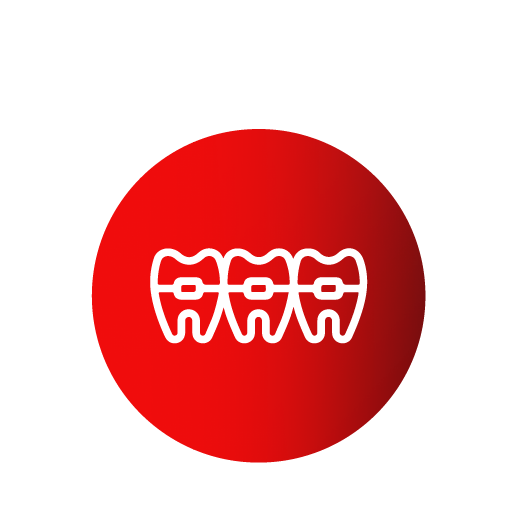
Orthodontic Treatment
Orthodontics is a specialist branch of dentistry. The term “orthodontics” can be broken down into two Greek words – “orthos” meaning straight or correct and “dontics” meaning teeth. Orthodontics, therefore, describes the practice of straightening misaligned teeth or malocclusions. Dentists who specialize in orthodontics can help manage abnormal positioning of the teeth, jaws, and face.
Benefits of orthodontics
Orthodontics has additional benefits over improving cosmetic appearance. The benefits of opting for straightening the teeth include:
- Improvement of self-esteem
- Improved function of teeth including better chewing and clearer pronunciation and speech
- Reduced risk of dental caries occurring due to the collection of food particles between the teeth
- Reduced risk of gum injury and trauma due to overbites and malocclusions
Aims of orthodontic treatment
- Providing cosmetic correction and improving appearance.
- Providing a healthy functional bite.
- Preventing diseases of the teeth.
Some of the dental malocclusions that may be corrected by orthodontics include:
- Crowded teeth: Crowding of teeth or poor alignment of teeth that may be too large for the mouth. This leads to a poor bite as well as an unsightly appearance. The most common teeth to crowd are the upper canine teeth.
- An open bite: This occurs when the lower end of the upper front teeth does not touch the upper end of the lower front teeth. This leads to insufficient chewing.
- Deep overbite: This describes when the top and bottom front teeth are not aligned and the bottom teeth tend to touch the roof of the mouth, sometimes damaging the gums and the palate. This may lead to gum damage, gum diseases, tooth loss, and tooth wear.
- Crossbite: This occurs when the teeth ends do not meet. It leads to poor appearance, insufficient chewing, and easily erodible teeth.
- Increased overjet: This describes when the upper teeth protrude and may result from thumb or finger sucking. This may also be due to uneven jaw bone growth.
- Reverse overjet: The lower jaw protrudes beyond the upper jaw. Aside from poor cosmetic appearance, it can lead to worn teeth.
- Spacing: Unnatural spacing between teeth may result from poorly developed, smaller, or missing teeth.
Methods adopted by orthodontics specialists
Teeth can be straightened in adults, adolescents, or children, using braces that may be adjusted and may straighten the teeth while allowing for growth and development.
Orthodontic treatments could involve fixed or removable appliances. Depending on how severe your situation is, your orthodontist will advise you on which approach is the right one for you.
Fixed appliances include:
- Braces: You’ve most likely heard of braces – they’re the most common fixed appliance. They consist of bands, wires, and brackets. The bands are the anchors held in place around your teeth. Brackets are attached to the front of your teeth. Arch wires connect the brackets to the bands. Tightening the archwires puts pressure on your teeth, slowly moving them towards their target position. Braces are usually adjusted monthly and are worn for a few months to a few years.
- Special fixed appliances: These should only be used as a last resort to control thumb sucking or tongue thrusting. Since they’re attached to the teeth by bands, they can feel quite uncomfortable while eating.
- Fixed space maintainers: Sometimes, young children lose their teeth prematurely. In such situations, an orthodontist might place a space maintainer in your child’s mouth to keep the space open until a permanent tooth appears.
Removable appliances include:
- Aligners: These are increasingly becoming a popular alternative to traditional braces for adults. Aligners move teeth in the same way as braces, but they are virtually invisible and don’t involve metal wires and brackets. If you’re using them, you need to remove them while eating, brushing, and flossing.
- Removable space maintainers: These devices are used for the same reason as fixed space maintainers. They’re made up of plastic or wire branches and an acrylic base that fits over the jaw. They’re placed in open spaces between teeth to keep the teeth apart.
- Jaw repositioning appliances: These appliances are also known as splints. They’re placed either on the top or lower jaw and are used to treat TMJ disorders by training the jaw to close in a better position.
- Lip and cheek bumpers: Your lip and cheek muscles might exert pressure on your teeth. In such cases, you can use bumpers to keep your lips and cheeks away from the teeth.
- Palatal expander: This device is a plastic plate that fits over the roof of the mouth. It’s used when the arch of your upper jaw needs to be widened.
- Removable retainers: These devices, worn on the roof of the mouth, prevent
your teeth from shifting back to their previous position. - Headgear: These devices slow down the growth of the upper jaw. They also hold the back teeth in place while the front teeth are pulled back.
Schedule your dental visit today!
Watch the Procedure Video
Office Hours
- Monday:7:00 am – 7:00 pm
- tuesday:7:00 am – 7:00 pm
- wednesday: 8:00 am – 5:00 pm
- thursday: 8:00 am – 4:00 pm
- friday:7:00 am – 7:00 pm
- saturday:Closed
- sunday:Closed
Ask the Expert
Have a brief question you would like answered by one of our experts? Please use the form below:


